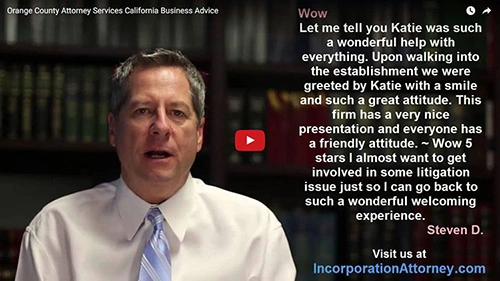Corporate Records Management in California
Kick-off with a
Call Today!
Your Corporate Records are more than just the assortment of papers and forms that the law and the IRS require you to have an update every year in order to be, and stay, legal.
Corporate Records are the documentation that demonstrates that you run your company properly and professionally. Good, well-maintained records demonstrate that the corporation has an attention to detail. Attention to detail in one area easily leads one to the conclusion that there is attention to detail in other areas as well.
 Sloppy, poorly organized records are evidence of the fact that a corporation that cannot do something simple as holding meetings and noting decisions could easily make missteps or commit other wrongs as well.
Sloppy, poorly organized records are evidence of the fact that a corporation that cannot do something simple as holding meetings and noting decisions could easily make missteps or commit other wrongs as well.
Certainly, a primary goal when you started your business was to make money. The purpose of forming a corporation is to protect that money. The last thing you want is to risk losing your money and/or your other assets.
Make no mistake, if you do not keep good records, you allow the protective wall you built to separate your personal assets from the corporation’s liability, your ‘corporate veil’, to crumble. Essentially, you open yourself up to losing everything, not just from a business perspective, but personally as well.
What are Corporate Records Exactly, What Should You Document, E3, and How?
Based in Orange County California and serving literally hundreds of companies both nationally and in California, Incorporation Attorneys have gained over twenty years of experience in seeing the kinds of real issues that come up. How poor or effective Corporate Documents Management can play both a negative or positive critical role in protecting those businesses.
Below we will discuss the various aspects of corporate record management from a best practice point of view.
Corporate Records – Different Businesses, Different Issues
Different types of businesses tend to encounter different types of issues. Is your business a contracting business, a dog washing business, an internet business? Do you have partners? Are you going to have outside investors? Do you use your cars or do you have multiple transportation vehicles? Do you do business out of multiple locations? Do you want to contract in just California or do you contract in other States? Understanding operational parameters like these are critical to understanding the types of risks and the probability of certain types of issues typical businesses are most likely to encounter.
Understanding the nature and the rate of changes within a business is a key part of understanding what types and the “why of things” should be documented and how that will aid in protecting the organization.
Is this Process the Same for Sole Proprietorships’ and Corporations?
It’s important to understand the core distinction between these different business vehicles. Although they are all business entities, they are very different in how the documents are managed.
In a sole proprietorship, the owner accepts full responsibility for control of all the assets, and acceptance of all the liability.
For example, let’s say a baker’s assistant delivers a loaf of bread and in the process of doing so, runs over someone on the crosswalk. In that case, the assistant and the proprietor are fully responsible. That’s one of the giant negatives of being a sole proprietor.
In this article, we are specifically focusing on the activities required of corporations and the best practices for corporate record keeping.
What are Annual Corporate Records?
There are a number of legal and financial documents that either have to be created, renewed, or documented every year. It may be a pain, but it does not have to be challenging if you know what you are doing and pay attention to the right details. The state regulates many of the activities of its citizens. For example, the ability to lawfully operate a vehicle in the state is determined by the Department of Motor Vehicles. The ability to lawfully operate a corporation in the state is a bit more complicated in that it is regulated by many different state agencies, the principal of which is the California Secretary of State.
The law requires that the corporation prepare, send notices and conduct at least two specific meetings every year. The two types of meetings are the “annual meeting of the board of directors” and the “annual meeting of the shareholders.”
All states require that the corporation hold meetings each year and memorialize the decisions made including who will fill the positions of president, secretary, and treasurer of the corporation, all corporations. All corporations are required to do this.
The states also require that it be notified as to who will be acting in the capacity of corporate directors. This information is typically provided to the state using a special form provided by the State. The form is different for each State.
If the corporation doesn’t prepare and file these notices in a timely manner, the corporation will pay fines and penalties. If it is left long enough, the state will even take away the ability for the corporation to conduct business in the state, defend itself against lawsuits in the courts, and could even result in the loss of the corporate name.
Corporate Records – Special Meetings, what needs to be documented?
Although there are two meetings that are required, the “annual meeting of the board of directors” and the “annual meeting of the shareholders“, a corporation may also have “special” meetings of the board of directors and or the shareholders.
Smaller Companies Special Meetings – The Shareholders are also the Directors
In smaller companies, shareholders are the same people as the directors. This can lead to confusion over the meetings and responsibilities of the shareholders versus the directors. To better understand the process it helps to view these positions as held by different people. Rather than Tom acting as a director and a shareholder, think of each job done by different people. For example, Tom is the director and Mary is the president. If this is the case in your organization, visualize yourself wearing different hats, one as a shareholder and another as a director. Hold and document separate meetings accordingly.
Visualize the shareholders as passive in the sense that they invest in the business. They hire a board of directors to establish the direction and set the vision of the business. The corporate officers (the president, secretary, and treasurer) run the business on a day-to-day basis.
For the shareholders, an annual meeting with quarterly financial reports may be sufficient. For the board of directors, more frequent “special” meetings may be important depending on the level of activity and change in the organization.
Corporate Records – Shareholder Special Meetings
An example of when “special” shareholder meetings might be appropriate is when a director needs to be removed from the board. The shareholders would call a special meeting. They would announce the problem has occurred with one of the members of the board. Shareholders would nominate and elect a replacement director.
Other examples occur when:
- A director develops a business that is in conflict with the corporation and needs to be replaced.
- Another investor is brought in and shares need to be issued to the new investor.
- The corporation needs to raise new capital.









